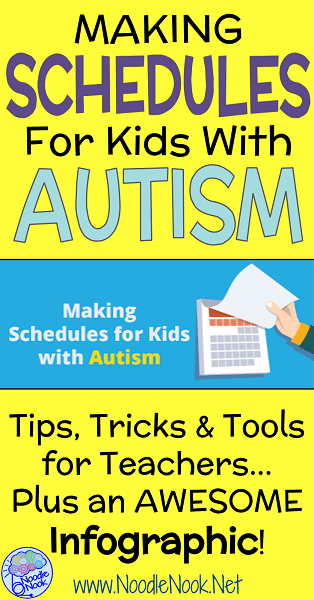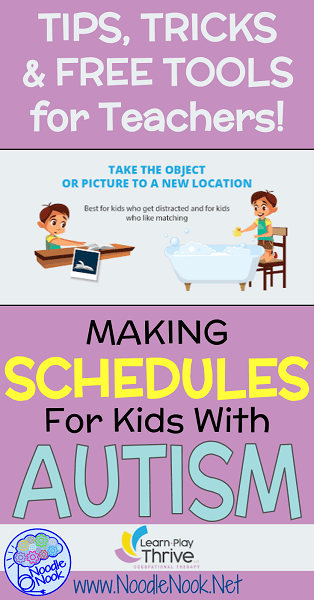I am honored to have Meg from LearnPlayThrive.com guest post on our blog and provide a fantastic infographic on making schedules for kids with Autism.
Noodle Nook has posted before on the importance of having and using schedules when you teach students with Autism.
For more on WHY to have schedules, please pop over and read 6 Steps to a Successful Autism Unit and for some FREE visuals to use while making student schedules, visit Visual Schedules in Autism Classrooms and Free Visual Supports for Students with Autism.
Have you ever made a schedule for a child with autism only to have them throw it or completely ignore it? I know I have!
This infographic walks you through some of the decisions to make when designing a schedule for a child with autism.

Keep In Mind
Here are a few things to keep in mind:
Design a schedule for what your student needs on their worst day, not on their best day.
If your student is an emerging reader, it’s probably best to stick with pictures for their schedule. An analogy I like to give teachers is this: My Spanish is pretty darn good, but if I’m stressed or need to do something really important, I certainly hope my instructions are in English.
Expect to spend a couple of weeks teaching the schedule to the student.
They may not get it right away, but should start to at least show that they understand what the schedule means after a few tries. If it’s not working, don’t be afraid to head back to the drawing board and make some changes.
This one is hard for teachers: don’t make it beautiful on the first try.
Don’t even laminate it! Once you’ve spent lots of time making something perfect, it can be hard to want to change it. If you make your first draft quick and dirty, you’ll be much more prepared to make the necessary changes as you learn about what your student needs from their schedule.
I hope you find this infographic helpful! It’s based in the TEACCH Ⓒ approach to designing schedules. Feel free to share it on your own site with a link back to learnplaythrive.com
About Meg Proctor: I’m an autism specialist, occupational therapist, and the founder of Learn Play Thrive. I use telehealth to coach parents of kids with autism in Mississippi, North Carolina, and (beginning fall 2018) California. I also provide trainings and consultations to teachers and schools. You can find lots of tips for working with your students with autism at learnplaythrive.com/autism-resources




